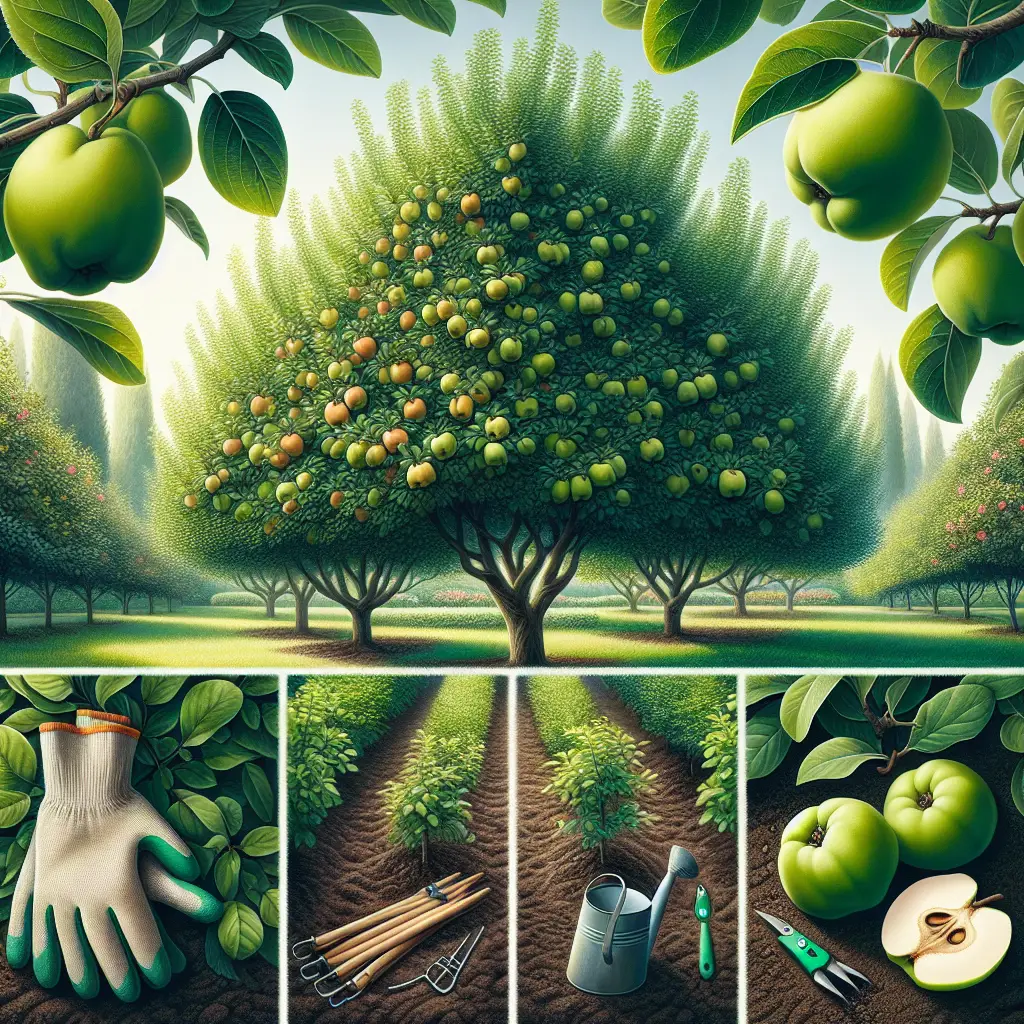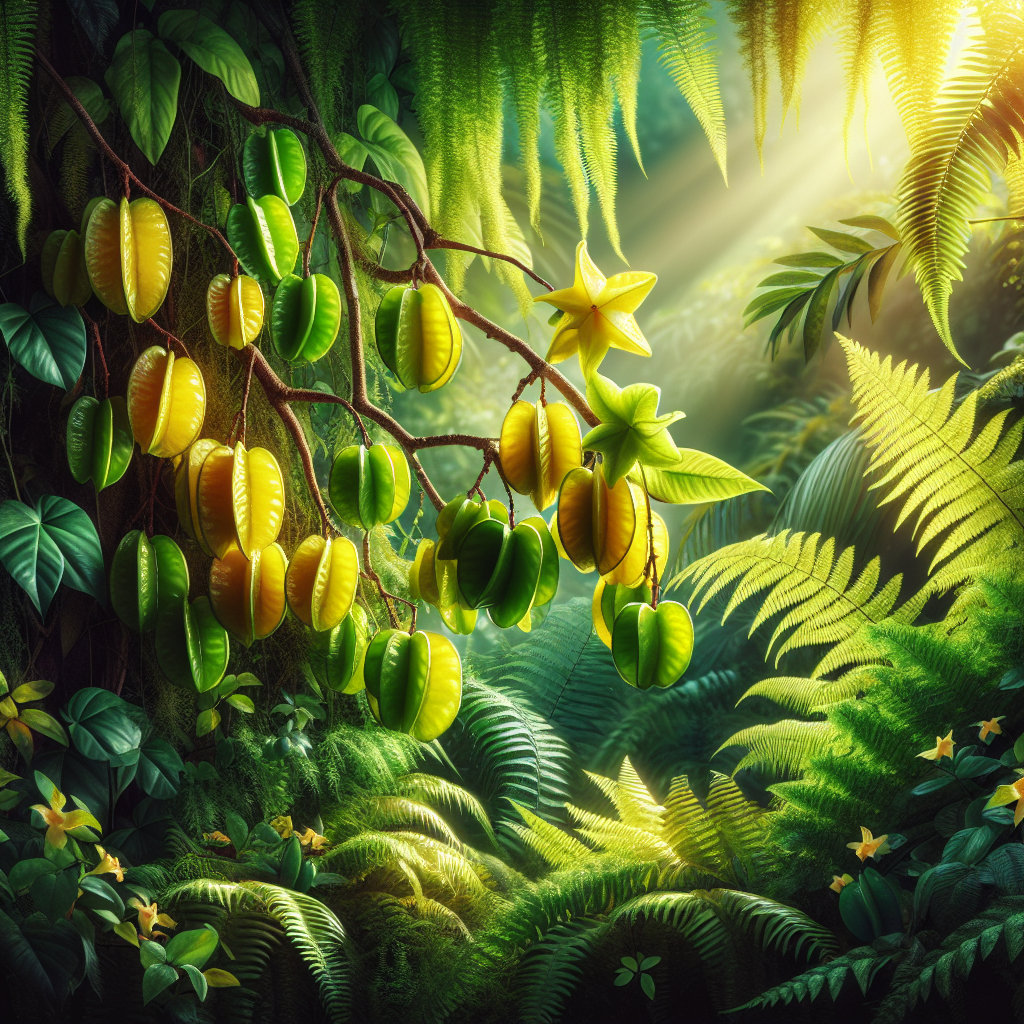Tips for Growing Healthy Quince Trees
Published January 13, 2024 at 9:06 pm

Understanding Quince Trees: An Overview
- Pet Friendly: Quince trees are generally considered pet-friendly. However, their fruit should not be consumed by pets as it may cause gastrointestinal discomfort when raw.
- Light Requirements: These trees thrive in full sun, which means they require at least six hours of direct sunlight daily.
- Watering: Regular watering is important, particularly during the tree’s formative years and in dry periods, though mature trees are quite drought tolerant.
- Humidity: Quince trees can handle most humidity levels but they prefer a drier climate to prevent diseases like leaf blight.
- Temperature: They grow best in temperate climates without extreme summer or winter temperatures.
- Difficulty: Quince trees are moderately easy to grow, with some care requirements for pest and disease management.
Choosing the Right Location for Your Quince Tree
When planting a quince tree, picking the right spot in your garden is crucial. Like many fruit trees, quinces need plenty of sunshine to produce a good yield. Make sure the location you choose gets full sun—this will help maximize fruit production and enhance the flavor of the quinces. Avoid low-lying areas where cold air settles as early frosts can damage the blossoms, reducing your seasonal harvest.
Soil Requirements: Ensuring Good Drainage and Nutrient Balance
Quince trees are not too picky about soil as long as there’s good drainage. They can handle a range of soils but struggle in clay with poor drainage or in very sandy soils that dry out too fast. Aim for a pH between 6.0 and 7.0 for optimal growth. You can mix in some compost or aged manure to improve soil fertility before planting. Mulching around the base helps retain moisture and suppress weeds.
Planting Your Quince Tree: A Step-by-Step Guide
To plant your quince tree, dig a hole that’s twice as wide as the root ball but just as deep. This allows the roots to spread out easily without forcing the tree to sit lower than it should. When positioning the tree in the hole, ensure it’s not planted deeper than it was in the pot. Backfill with soil gently, avoiding compacting it too much. Water the tree thoroughly after planting to settle the soil and eliminate air pockets.
Watering Practices for Healthy Growth
Water newly planted quince trees regularly to establish a strong root system, typically once a week if there’s no rain. Avoid over-watering as this can lead to root rot. Settling for deep, infrequent watering encourages the roots to grow deeper into the soil. After the first few years, quince trees are fairly drought-tolerant; however, during prolonged dry spells, it’s beneficial to give them an occasional soak.
Fertilization: When and What to Use
The first year after planting, your quince tree won’t need much fertilization as you want to encourage root growth rather than rapid shoot development. From the second year onwards, use a balanced fertilizer like a 10-10-10 NPK formula in spring, just as the new growth appears. If your tree is growing vigorously with good fruit production, you might not need to fertilize it as often. Pay attention to the tree’s growth and fruiting cues.
Find This and More on Amazon
Pruning Quince Trees: Techniques and Timing
Pruning is an essential part of quince tree care. The best time to prune is in late winter before new growth starts. Always remove any dead or diseased wood, crossing branches, and suckers from the tree’s base. Aim to create an open center in the tree’s canopy to allow for sunlight penetration and air circulation. This can help reduce the risk of fungal diseases and promote a good crop.
Common Pests and Diseases: Preventative Measures
Quince trees are susceptible to pests like codling moths and diseases such as fire blight and quince leaf blight. To control pests, pheromone traps and proper sanitation practices like removing fallen fruit and leaves can be effective. For diseases, applying a copper-based fungicide before buds break in spring may be necessary in some areas.
Recognizing and Treating Quince Tree Ailments
If your quince tree exhibits signs of disease like dark, sunken lesions on the branches indicating fire blight, act quickly. Prune affected branches well below the damage and sanitize your tools between cuts. Leaf blight is marked by spots on leaves that turn yellow and fall off. Improved air circulation and avoiding overhead watering can help prevent this issue.
Harvesting Quince: Timing and Techniques
Quinces are typically ready for harvest in late autumn when the fruits turn yellow and are aromatic. However, unlike other fruits, quinces are hard and sour when raw. They need to be cooked to bring out their sweet, floral flavor. Harvest by gently twisting the fruit off the branch, being careful not to bruise them as this can lead to quicker spoilage.
Ripening and Storing Quinces
After harvesting, you might need to store quinces to further ripen. A cool, dark place is ideal for this process. Once ripe, quinces can be stored in the refrigerator where they will keep for several weeks. If you plan to use them for cooking, consider making preserves or chutneys, which capture the unique quince flavor and extend their shelf life even further.
Using Quince in the Kitchen: Delicious Ideas
Quince paste, also known as membrillo, is a classic preparation that pairs wonderfully with cheese. Quinces also make exquisite pies, tarts, and poached fruit desserts. Their high pectin content makes them fantastic for jams and jellies. Experimenting with quince in your cooking can be a delightful way to enjoy this unique fruit.
Mulching and Weed Control for Quince Trees
Mulching is not only good for moisture conservation but also for keeping weeds at bay which can compete with your quince tree for nutrients. Organic mulches like straw or wood chips are beneficial as they break down over time and enrich the soil. Remember to keep mulch away from the trunk to prevent rot and discourage rodents.
Understanding the Growth Habit of Quince Trees
Quince trees can grow quite large, up to 15-20 feet in height and spread, so it’s important to consider this when planting. They have a naturally bushy growth habit that can be trained into a more tree-like form with careful pruning. Understanding their growth pattern helps with garden planning and ensures that your quince gets the space it needs.
The Importance of Cross-Pollination for Quince Trees
While some quince varieties are self-fertile, they often benefit from cross-pollination with another quince tree or even certain pear varieties. Planting more than one tree can increase fruit yield and quality. If space is a concern, consider grafting a branch of a different variety onto your quince for cross-pollination purposes.
Thinning Fruit for Better Quality Harvests
If your quince tree is particularly prolific, it may be necessary to thin the young fruit to ensure better growth and reduce limb breakage. This also allows for larger, higher-quality fruit at harvest. Thinning by hand is usually the best method, removing excess fruit when they are small, ensuring about 4-6 inches between remaining fruits.
Using Protective Netting for Fruiting Quince Trees
Birds can sometimes be a problem for quince trees once the fruit begins to ripen. Protective netting placed over the tree can safeguard your crop. Ensure the netting is secured around the trunk to prevent birds from accessing the fruits from beneath and choose a wildlife-friendly option that won’t harm birds or other creatures.
Seasonal Care for Quince Trees
Seasonal care is important for quince trees. They may need extra water in the summer heat, especially in the drier climates. Winter protection might consist of laying a thick layer of mulch around the tree’s base to protect the roots from freezing temperatures. Keep an eye on the weather forecasts to be ready to protect your quince tree during particularly harsh conditions.
When to Call a Professional Arborist
There will be times when calling in a professional arborist is the best course of action, such as when diagnosing a complex disease or conducting major structural pruning. They have the expertise to handle these tasks properly and assist with the long-term health of your quince tree. Don’t hesitate to consult with one if you’re unsure about any aspect of your quince tree care.
Creative Landscape Design with Quince Trees
Quince trees don’t just bear delicious fruit, they’re also beautiful additions to any landscape. They offer lovely blossoms in the spring and have a stunning leaf display in the fall. When planting quince trees, think about how they fit into your overall garden design, perhaps as a focal point or part of an edible border.
Incorporating Quince Trees in a Permaculture Garden
In a permaculture garden, quince trees can play an important role. They provide food, can serve as windbreaks, and offer habitat for beneficial insects. Interplanting with companion plants that attract pollinators and deter pests is a smart way to increase garden biodiversity and the health of your quince tree.
Fun Facts About Quinces
Quinces have a rich history and have been cultivated for thousands of years. They were once considered a symbol of fertility and love. Interestingly, some believe that the ‘forbidden fruit’ in the Garden of Eden was not an apple but a quince. These fascinating stories add an extra layer of enjoyment to growing your own quince trees.
Engaging with the Quince Tree Community
Joining local garden clubs or online forums dedicated to quince trees can be a great way to learn and share information. Fellow quince enthusiasts often have tips and tricks that are specific to your area and climate, which can be invaluable as you care for your trees and process the harvest.
Embracing Sustainability with Quince Trees
By growing quince trees, you’re participating in a sustainable practice. Quinces are relatively low-maintenance once established and can produce fruit for many years. They’re a great addition to a sustainable homestead, providing fresh fruit that can be preserved in various forms without the need for long-distance transportation.
Optimizing Quince Fruit Production
Maintaining optimal fruit production requires monitoring for nutrient deficiencies. Yellowing leaves might indicate a lack of nitrogen, while poor fruit set could suggest a shortage in potassium. A soil test can guide your fertilization plan, ensuring that your quince trees have all they need to provide bountiful harvests annually.
Conserving Water with Quince Trees
While quince trees are somewhat drought-tolerant, they still benefit from efficient watering techniques. Drip irrigation or a soaker hose can deliver water directly to the roots, reducing waste and evaporation. Conserving water is not only good for the environment but also for your water bill, making it an ideal practice for the eco-conscious gardener.
Protecting Quince Trees from Harsh Weather
Extreme weather conditions can stress quince trees. In hot climates, using shade cloth during the intense midday sun can prevent scalding on the fruit and leaves. In winter, protect trees from frost damage by covering them with burlap or frost cloth if they are young or if a particularly cold snap is expected.
Reviving an Old Quince Tree
If you inherit an old, neglected quince tree, it’s possible to revive it back to health. Start by removing any dead wood and perform restorative pruning over several seasons. Provide it with balanced nutrition and ensure it’s receiving adequate water. With care and patience, you might just breathe new life into an old tree, reaping rewards of flavorful quinces for your effort.
Companion Planting with Quince Trees
Companion planting can provide numerous benefits for your quince tree, from improving soil health to attracting beneficial insects. Consider planting legumes nearby to help fix nitrogen in the soil or flowering herbs to draw in pollinators and predatory insects that will keep pest populations in check.
The Lifecycle of a Quince Tree
Understanding the lifecycle of a quince tree can help you provide better care year-round. In spring, they bloom with stunning flowers, followed by leafing out. After pollination, the fruits develop through summer and ripen by autumn. Winter is a time for dormancy, which is essential for the tree’s rest and rejuvenation before another productive year.
Homemade Treatments for Quince Tree Care
You might find homemade treatments beneficial for your quince trees. For example, a homemade garlic spray can deter pests, while a baking soda solution can help manage fungal diseases. Be sure to research and test any home remedy on a small scale before applying it widely to ensure it’s safe for your tree.
Landscaping Challenges with Quince Trees
While quince trees are beautiful, they come with their own set of landscaping challenges. Their tough roots can interfere with nearby structures, and their extensive canopy may overshadow smaller plants. Planning and positioning your quince tree carefully from the outset can help avoid these complications in the future.
Supporting Biodiversity with Quince Trees
Planting quince trees contributes to biodiversity by providing a habitat and food source for various wildlife, from bees and butterflies to birds. This not only benefits the environment but also helps your garden’s entire ecosystem become more resilient and self-sustaining.
Documenting Your Quince Tree’s Growth
Keeping a garden journal that includes your quince tree’s growth can be rewarding and informative. Document when it blooms, signs of pest or disease problems, and your harvest results. This record can help you make more informed decisions about care and maintenance over the years.
Intriguing Quince Tree Varieties
There are several intriguing quince tree varieties to choose from, each with unique characteristics. For instance, the ‘Pineapple’ quince is known for its pineapple-like flavor, while the ‘Portugal’ quince has particularly large, pear-shaped fruits. Exploring different varieties can add diversity to your harvest and kitchen creations.
Aligning Quince Trees With Your Lifestyle
Quince trees can be a fantastic fit for various lifestyles. Whether you’re a dedicated gardener seeking a new challenge, a homesteader looking to expand your self-sufficient practices, or an urban dweller with a single tree in the backyard, quinces offer a unique and satisfying experience.
Learning From Quince Tree Failures
It’s okay if not everything goes perfectly with your quince tree—failures can be a valuable learning tool. Whether it’s a poor harvest one year or a battle with a persistent pest, each challenge is an opportunity to grow your knowledge and adapt for future success.
Conclusion: Enjoy the Fruits of Your Labor
The journey of growing healthy quince trees can be as rewarding as the delicious fruits they produce. With attention to their needs and care throughout the seasons, your efforts will be paid off with fragrant and versatile fruits that can be enjoyed in countless ways. Engage with your trees, embrace the lessons they offer, and relish in the vibrant tastes and experiences they bring to your table.
Shop more on Amazon

